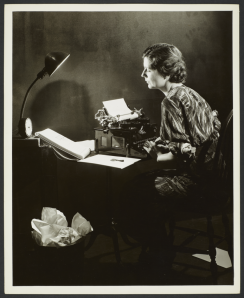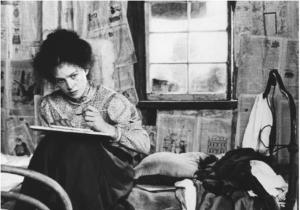Chapter 3 of my thesis focuses on authorship, and you can find a draft of the first part of the chapter underneath. As I stated before, any feedback is of course more than welcome but please take into account that these are just fragments in process which are part of a larger (undefined) ‘whole’.
For chapter 2 of my thesis, see here and here. I will post the remainder of chapter 3 later this week. You can find part 2 here and part 3 here.
Chapter 3. The perseverance of print-based authorship within humanities scholarship
I think that, as our society changes, at the very moment when it is in the process of changing, the author function will disappear, and in such a manner that fiction and its polysemous texts will once again function according to another mode, but still with a system of constraint – one that will no longer be the author but will have to be determined or, perhaps, experienced [expérimenter].
(Foucault 1977)
The roles and functions of the scholarly author
 Authorship within academia has reached a cult status. Scholars, in the humanities at least, are increasingly assessed according to the weight of their individual, single authorial output in the form of published articles or books and less according to the quality of their teaching, to take just one possible instance. The evaluation of a scholar’s authorial contributions to a field is considered essential for hiring purposes and further career and tenure development, for funding and grant allocations, as well as for interim institutional assessments such as the REF in the UK. Authorial productivity and, connected to this, the originality of one’s work, increasingly determines a scholars standing within academic value networks. This fetishisation of scholarly authorship is integrally connected to an increasingly hegemonic academic discourse related to originality, authority and responsibility, and linked to a humanist and romantic notion of the individual author-genius. This specific discourse on authorship is directly connected to a certain essentialist idea of ‘the human’ which one could argue the humanities, and with that scholarship as a whole, is based upon (Weber 2000, Fisher 2013). This is the idea of the universal human, the sovereign human individual, and of the self as unity, which can be translated, as Gary Hall has done, into the idea of ‘the indivisible, individual, liberal human(ist) author’ (Hall, G. 2012). Although, as Hall also states, this idea of human essence, of a unified self and a integral individual has been criticised and interrogated by critical theorists for over a century now, the way knowledge is produced, consumed and disseminated remains very similar to the print-based authorship practices devised as part of the discourse on the humanist author. This discourse continues to shape our academic authorial practices, in conjunction with our publishing practices, even in an increasingly digital environment.
Authorship within academia has reached a cult status. Scholars, in the humanities at least, are increasingly assessed according to the weight of their individual, single authorial output in the form of published articles or books and less according to the quality of their teaching, to take just one possible instance. The evaluation of a scholar’s authorial contributions to a field is considered essential for hiring purposes and further career and tenure development, for funding and grant allocations, as well as for interim institutional assessments such as the REF in the UK. Authorial productivity and, connected to this, the originality of one’s work, increasingly determines a scholars standing within academic value networks. This fetishisation of scholarly authorship is integrally connected to an increasingly hegemonic academic discourse related to originality, authority and responsibility, and linked to a humanist and romantic notion of the individual author-genius. This specific discourse on authorship is directly connected to a certain essentialist idea of ‘the human’ which one could argue the humanities, and with that scholarship as a whole, is based upon (Weber 2000, Fisher 2013). This is the idea of the universal human, the sovereign human individual, and of the self as unity, which can be translated, as Gary Hall has done, into the idea of ‘the indivisible, individual, liberal human(ist) author’ (Hall, G. 2012). Although, as Hall also states, this idea of human essence, of a unified self and a integral individual has been criticised and interrogated by critical theorists for over a century now, the way knowledge is produced, consumed and disseminated remains very similar to the print-based authorship practices devised as part of the discourse on the humanist author. This discourse continues to shape our academic authorial practices, in conjunction with our publishing practices, even in an increasingly digital environment.
However, practices and discourses related to collaboration, networking and the greater academic conversation, have similarly fed our notions of scholarship over the centuries, and for many scholars the Internet and digital communication seem the perfect opportunity to promote these capacities further. Developments in the sciences, where multi-authorship has become common practice, also increasingly challenge ideas of individual scholarship in the humanities. Some even argue that networked science has the potential to fundamentally change the nature of scholarship and scientific discovery (Nielsen 2011).
In this chapter I will examine how we can explore and critique the role humanist authorship plays within academia (and within the humanities more in specific) by analysing the way authorship currently functions within scholarly networks, and how our authorial roles and practices are constructed and are performed as part of these. I will explore authorship from a historical, theoretical and practical perspective, in an effort to break down the discourse on the cult of individual authorship while also being critical of the—in some instances almost utopian—hope invested in scholarly practices of networked collaboration. I will do so by, among other things, analysing the history of authorship and the rise of the humanist authorial discourse which shows that single authorship is a very recent construct and that scholarship has always been collaborative and distributed. At the same time I will explore the mostly theoretical critique of authorship provided by poststructuralist thinkers, as well as what can be seen as some of the recent practical embodiments of that critique. Although we have been proclaiming the death of the author for several decades now, authorship remains strongly embedded within our institutions and cultural and social practices. In what follows I will analyse some recent practical experiments with authorship critique, including hypertext, which can be seen to focus mainly on replacing the authority and responsibility of the author with that of the reader. I will also look at remix practices within academia, which can be seen to mainly target the originality of authorship. Furthermore, I will investigate current practices of collaborative authorship within the digital humanities, which can be seen to foreground collaborative notions of authorship, challenging its presumed individualistic nature. However, as I will show, although interesting and promising, many of these recent collaborative, networked, interactive, multimodal, hypertextual, and remixed forms of authorship, proposed as an alternative to the above described humanist authorship discourse, nonetheless still resort to many of the same structures and practices.
I will end this chapter by putting forward two examples of what can be seen as an anti-authorship critique, namely plagiarism and anonymous authorship. This will lead to an exploration of the potential for a posthumanist critique of authorship and, as an extension of that, possible forms of posthuman authorship. Here posthumanist authorship wants to continuously rethink and reperform, both in theory and practice, the way authorship functions within academia. And in its critique of the humanist notions underlying authorship, it wants to explore and experiment with more distributed and posthumanist authorship practices.
Authorship and the discourse on book history
The relationship of book history and book historians with authorship, its historical development, and the author function, has been changeable and complex. As book historian Roger Chartier argues, book history was developed within currents of literary criticism such as structuralism, analytic bibliography and new criticism, which was especially dominant in Anglophone countries, which all saw the text, and thus books, as self-containing systems, without authors and readers. As Chartier claims, the history of the book was thus for a long time a history with neither readers nor authors (1994: 24–25). In the French school of the histoire du livre, the situation was initially not much better, although it focused at least on the sociology of readers (although not on reading practices). In France, just as in the Anglo-Saxon bibliographic school, the author was forgotten, even in the tradition of the social history and the material production of the book, as produced by Febvre and Martin, among others. In France, Chartier claims, books thus had readers but no authors (1994: 25–26). However, Chartier sees attention to the author return in Bourdieu’s sociology of cultural production, McKenzie’s sociology of texts, reception history within literary criticism, and new historicism. A constrained author, as Chartier calls it, as opposed to a romantic one, returns here, as in these theoretical systems the text and the book are reconnected with their author and her or his intentions. Chartier applauds this return of the author as a subject of investigation in book studies, especially and more precisely, of the author function and its practice and techniques.
One of the questions concerning authorship that plays an important role in the book historical discourse is whether it is print that established or enabled our modern notion of authorship, or whether authorship predates print? For instance, Chartier focuses on how in its connection with censorship and literary or scholarly property and ownership, authorship is fully inscribed with (the culture of) print. Print extended the circulation of potentially transgressive books and it established a market system in which proper roles where established (author, publisher, bookseller etc.). At the same time, he argues that certain essential traits of authorship predate print. Already in the manuscript age authors, such as Petrarch, tried to establish control over the way their texts looked and were distributed, especially with respect to corruption through continual copying by copyists. According to Chartier, this shows an early emergence of ‘one of the major expressions of the author-function, the possibility of deciphering in the forms of a book the intention that lay behind the creation of the text’ (Chartier 1994: 55).
 Ong also locates the beginning of authorship before print, namely with the coming of written discourse. Where orality is performative and produces community, written discourse, he states, is detached from the performer, it starts to become an autonomous thing where it turns the writer into a subject distinct from the group. As Ong puts it, ‘with writing, resentment at plagiarism begins to develop’ (Ong 1982: 128). In manuscript culture, however, intertextuality continues to rule, where it is still connected to the commonplace tradition of the oral world, creating and adapting texts out of other texts. As McLuhan emphasises, written text was still authorative only in an oral way (McLuhan 1962: 104). Both Ong and McLuhan thus argue that it was print that truly created the sense of the private ownership of words and that created a new feeling for authority, where print and its visual organisation encourages a different mindset. A work becomes closed, cut off from other works and unique. It was print culture which, according to Ong, finally enabled romantic notions such as originality and creativity to arise and which encouraged the development of our modern notion of authorship (Ong 1982: 130–131). As McLuhan stated in this respect, ‘scribal culture had neither authors, nor readers’ (McLuhan 1962: 130).
Ong also locates the beginning of authorship before print, namely with the coming of written discourse. Where orality is performative and produces community, written discourse, he states, is detached from the performer, it starts to become an autonomous thing where it turns the writer into a subject distinct from the group. As Ong puts it, ‘with writing, resentment at plagiarism begins to develop’ (Ong 1982: 128). In manuscript culture, however, intertextuality continues to rule, where it is still connected to the commonplace tradition of the oral world, creating and adapting texts out of other texts. As McLuhan emphasises, written text was still authorative only in an oral way (McLuhan 1962: 104). Both Ong and McLuhan thus argue that it was print that truly created the sense of the private ownership of words and that created a new feeling for authority, where print and its visual organisation encourages a different mindset. A work becomes closed, cut off from other works and unique. It was print culture which, according to Ong, finally enabled romantic notions such as originality and creativity to arise and which encouraged the development of our modern notion of authorship (Ong 1982: 130–131). As McLuhan stated in this respect, ‘scribal culture had neither authors, nor readers’ (McLuhan 1962: 130).
How did authorship develop in a print environment? When it comes to early publishing, Eisenstein explains that the modern division of labour was not yet very common. Printers were mostly printer-publishers and many academics, such as Johannes Kepler, were themselves publishers or were very much involved in the printing process (Eisenstein 1979: 18). As Eisenstein points out, early printers played an important role in forging definitions of property rights, in shaping new concepts of authorship, and in exploiting new markets (Eisenstein 1979: 122). However, their labours would not have had much result in the manuscript age, as Eisenstein argues it was only with the coming of print, and with that of a fixed text, that individual innovations and discoveries could became more explicitly recognized and that the distinction between copy and original could become clear (Eisenstein 1979: 119–120). After the advent of copyright especially, it became much easier for an author to make a profit by publicly releasing a text, as their invention rights were now firmly established in law and no longer only guaranteed by guild protection (by the Stationers’ Company, for instance). Only with the coming of print, Eisenstein claims, could personal authorship really become established. People now wanted to see their work in print, fixed and unaltered. As she puts it, ‘until it became possible to distinguish between composing a poem and reciting one, or writing a book and copying one; until books could be classified by something other than incipits; how could modern games of books and authors be played?’ (Eisenstein 1979: 121). New forms of authorship and property rights thus started to undermine older forms of collective authority, which was exposed as error-prone. Where innovation came from was hard to determine before print, Eisenstein points out, as due to drifting texts and a lack of access to manuscripts, it was hard to establish what was already known and who was the first to know it. In other words, there was no systematic forward movement (Eisenstein 1979: 124). The term original also started to change its meaning. Initially, it meant ‘close or back to the sources’. The modern meaning, however, focuses on breaking with tradition. According to Eisenstein, it was print that started to change this meaning of original, as notions of recovery and discovery were reoriented after the coming of print technology (Eisenstein 1979: 192).
Printer-publishers also started to construct the author as a marketing product. This meant that new publicity techniques were explored, by printers as well as by authors, including marketing forms such as blurbs to publicly promote authors and sell their works (Eisenstein 1979: 229). Yet again, Eisenstein emphasises that this kind of marketing could only take place successfully and establish new forms of authorship after the coming of print. Scribal culture, she points out, ‘could not sustain the patenting of inventions or the copyrighting of literary compositions. It worked against the concept of intellectual property rights’ (Eisenstein 1979: 186).
Adrian Johns takes another approach with respect to the development of authorship, focusing mainly on the establishment of credentiality as part of the rise of authorship. How did readers ensure a work was authorative? It is important to keep in mind that compositors, just like modern editors, played an important authorial role, he argues. A copy of a manuscript could never be exactly reproduced in print, due to space constraints, for instance. Copies were thus amended during the printing process. For example, typography was used to enhance authorial meaning and changes were made in anticipation of a certain readership. Johns further remarks that original used to refer to a particular performance or reading of a work. This meant that written records were seen as a simple fallible transcription of a particular event. As Johns states, ‘compositors could thus make the changes their cultural position demanded, not only because of the prized virtue of the master printer, but also because they held in their hands no sacrosanct text at risk of desecration’ (Johns 1998: 105). According to Johns, copyright meant that a Stationer had a right to both the manuscript as well as the text. The Stationer thus protected his investment by turning this (fallible) transcription into a fully edited printed book (Johns 1998: 105). In this way Stationers and booksellers controlled every aspects of their books’ production.
The establishment of authorship as we know it today was very difficult in these conditions. Hence both Johns and Chartier argue that we should speak of forms of distributed authorship at that time, where authorship was allocated to a number of individuals and groups. Chartier points to Foucault’s focus on the penal background of authorship in this respect, when he states that ownership of a text has always been related to its penal appropriation. Books really became to have authors, instead of mythical figures, when authors became subject to punishment, and they could be held responsible for the diffusion of texts that were seen as scandalous or as guilty of heterodoxy. Chartier focuses on how this responsibility was initially a distributed responsibility. As he puts it:
In the repression of suspect books, however, the responsibility of the author of a censured book does not seem to have been considered any greater than that of the printer who published it, the bookseller or the pedlar who sold it, or the reader who possessed it. All could be led to the stake if they were convicted of having proffered or diffused heretical opinions. What is more, the acts of conviction often mix accusations concerning the printing and sale of censured books and accusations concerning the opinions—published or unpublished—of the perpetrator (Chartier 1994: 50).
 As part of the proprietry culture of that time and based on their right to copy, Stationers for a long time held the position of authors, specifically with respect to establishing credentiality (Johns 1998: 138). In forms of collaborative book production, however, establishing credentiality was harder, as no one publisher was responsible for the entire book. Nonetheless, the stationer was, for all means and purposes, the proprietary author of the book, the one who was responsible for the content. Febvre and Martin explain that authors had no right to their work once it was bought and published, as then the copy was vested in the publisher (Febvre and Martin 1997: 162.). As Johns makes clear: ‘certainly, this was designed to give the state someone to prosecute: its aim was to create a person in whom responsibility for the contents of the work could be said to reside. But it was also hoped that the device would eliminate unauthorized printing—the practice increasingly called “piracy”’ (Johns 1998: 159–160).
As part of the proprietry culture of that time and based on their right to copy, Stationers for a long time held the position of authors, specifically with respect to establishing credentiality (Johns 1998: 138). In forms of collaborative book production, however, establishing credentiality was harder, as no one publisher was responsible for the entire book. Nonetheless, the stationer was, for all means and purposes, the proprietary author of the book, the one who was responsible for the content. Febvre and Martin explain that authors had no right to their work once it was bought and published, as then the copy was vested in the publisher (Febvre and Martin 1997: 162.). As Johns makes clear: ‘certainly, this was designed to give the state someone to prosecute: its aim was to create a person in whom responsibility for the contents of the work could be said to reside. But it was also hoped that the device would eliminate unauthorized printing—the practice increasingly called “piracy”’ (Johns 1998: 159–160).
What kind of options did authors have in this situation? How could they control their authorship, when the publishers’ market-based conventions were so dominant? Did publishers control printed knowledge in this respect? As Johns states: ‘authorial civility was inextricably entangled with Stationers’ civility. For the modern figure of the individualized author to be constructed, this had to change’ (Johns 1998: 246). What is clear, Johns argues, is that the situation changed once authorship and copyright were embedded in law. With this the notion of authorship started to change too, where the Lockean idea of invention as the mark of property started to gain wider ground (Johns 1998: 247).
In opposition to Eisenstein, among others, Johns thus emphasises that authorship and authority are a matter of cultural practices and negotiation; they are conventions that could and can be challenged. We should see them as attributions to a book (by various groups and individuals such as publishers, readers etc.) instead of intrinsic attributes of a book (Johns 1998: 271). As Johns argues, then, in the battle surrounding how and to whom a book should be attributed credit or ownership, the author emerged. For scholars, forms of appropriation were a natural part of publishing their book. To protect their reputation they needed to negotiate potential hazards such as piracy, translations, abridgements, commercial sustainability etc., all matters that could deeply harm a scholar (Johns 1998: 445). The priority disputes in experimental philosophy—linked to publishing—got increasingly complicated and urgent, Johns points out, where both the existence of a record as well as the identity of its contents mattered. A new proprietary culture was therefore set up around authorship to deal with these problems, through which the profession of the author emerged (Febvre and Martin 1997: 66). Johns explains that fixity and authorship were thus established together, as the establishment of a problem:
And as the recognition of authorship blossomed, so, in a mutually reinforcing process, arguments demonstrating a resolved identity for printing began to win the upper hand, and the credit of its products became more widespread. By the end of the nineteenth century, print and fixity were as firmly conjoined by culture as ever could have been achieved by machinery (Johns 1998: 632).
 Chartier warns however against pinpointing specific and unique historical moments of construction or determining causes for the rise of authorship and the author function. It is no good to focus on univocal solutions or oversimplified causes, he states. Book history can offer some insights in this problem, in all its variety, sketching out a possible path or focus point—such as the juridical, repressive and material mechanisms Chartier focuses on—however, it does not offer an answer to what authorship was, is, and will be (Chartier 1994: 59).
Chartier warns however against pinpointing specific and unique historical moments of construction or determining causes for the rise of authorship and the author function. It is no good to focus on univocal solutions or oversimplified causes, he states. Book history can offer some insights in this problem, in all its variety, sketching out a possible path or focus point—such as the juridical, repressive and material mechanisms Chartier focuses on—however, it does not offer an answer to what authorship was, is, and will be (Chartier 1994: 59).
What these discourses show is that authorship is integrally linked to developments in the commercial book trade, growing scholarly claims for priority and credit, and the expansion of ideas related to ownership, copyright and originality. As Mark Rose has argued, ‘the distinguishing characteristic of the modern author, I propose, is proprietorship; the author is conceived as the originator and therefore the owner of a special kind of commodity, the work’ (Rose 1993: 1). Although the debate on how authorship came about again focuses mainly on the medium vs. society binary, a further conclusion that can be reached is that authorship came to be entangled with the humanist characteristics now commonly attributed to the book. Fixed, essentialised, and bound as a book, romantic notions of authorship came to stand for a highly individualistic, authorative and original writer, who was to be connected to a permanent body of works. The commercial and capitalist nature of the book trade with its focus on propriety and ownership instilled the idea of copyright and property into the relationship between an author and her or his text.
Although these humanist notions of authorship—including the connotations of reputation, individual creativity, ownership, authority, attribution, responsibility and originality they carry—seem to be an integral part of the scholarly method, even despite fact that they are often critiqued, they are very hard to overcome. Nonetheless, it is important to continue to challenge these traditional concepts, discourses, institutions and practices of authorship within academia. First of all because these essentialised notions of authorship do not do credit to the more collaborative and networked authorial practices as they exist currently and as they have existed in the past, in academia and beyond. As Adrian Johns emphasises, agency is more complex and distributed than the highly individualist narratives accompanying romantic notions of authorship argue for. In this respect there is a ongoing clash between what Robert Merton has identified as the values of originality and communism in scholarship (Merton 1973).
Another reason to challenge humanist concepts of authorship relates to the function currently fulfilled by authors in the academic political economy. In an effort to gain reputation and authority in a scholarly attention economy, academic authors are increasingly depicted as being in constant competition with each other (for positions, impact, funding etc.), where scholars are still rewarded mostly on the basis of their publication track record, and on their reputation as individual authors. Academic authors are on the one hand turned into commodities, while on the other they increasingly need to act as entrepreneurs and marketeers of their own ‘brand’. This objectification of authorship at a time when ‘unoriginal’ thought, depicted as plagiarism, is heavily combatted and frowned upon, goes against some of the more distributive and collaborative notions, practices and discourses of authorship described above. Yet the latter can be seen to not only be just as prevalent in contemporary academia, but in many ways a more realistic depiction of scholarly authorial practices.
 Finally, the strength of the humanist discourse on authorship in academia can be seen to inhibit experimentation with different models and functions of authorship and forms of what can be called posthumanist authorship,1 and the possible potential of digital media to help rethink what authorship is and can be. This does not mean, as we will see in what follows, that digital forms of authorship are always a critique of the humanist notions underlying more traditional and print-based forms of writing; but I want to emphasise that, no matter how problematic they still might be, digital media do contain the potential to helps us rethink and re-perform authorship and to envision more ethical and inclusive forms of authorship within academia.
Finally, the strength of the humanist discourse on authorship in academia can be seen to inhibit experimentation with different models and functions of authorship and forms of what can be called posthumanist authorship,1 and the possible potential of digital media to help rethink what authorship is and can be. This does not mean, as we will see in what follows, that digital forms of authorship are always a critique of the humanist notions underlying more traditional and print-based forms of writing; but I want to emphasise that, no matter how problematic they still might be, digital media do contain the potential to helps us rethink and re-perform authorship and to envision more ethical and inclusive forms of authorship within academia.
In order to analyse some of the main theoretical and practical criticisms that have been brought forward with respect to romantic and humanist notions of authorship, the next section will explore some of the authorship critique expressed by poststructuralist thinkers in the 1960s and 70s. This will be followed by an analysis of three more recent assessments of authorship, which can all in their different ways be seen as a practical extension of the poststructuralists’ critique. As I will argue, these practical or embodied expositions target different aspects of the discourse of the humanist author, namely the author’s authority, individuality and originality. First of all I will analyse the position taken by theorists and practitioners of hypertext with respect to networked authorship, challenging the authority of the author by focusing on the power of the reader and on the author as a node in a distributed network of meaning production and consumption. Secondly I will look at some of the authorial practices that have been developed in the sciences and increasingly in the digital humanities, such as the spread of hyperauthorship and collaborative research work. These are challenging the individualistic nature of authorship and promoting increasingly open-ended research practices and alternative (digital) views concerning creativity and invention. Finally, I will take a look at academic practices of remix, which are mainly critiquing the originality of authorship, where the trope of the remixer or curator seems to be increasingly prevailing in current scholarship on digital authorship, for instance (and the narrative of the former seems to be replacing the latter).
Critiquing authorship in theory
Kathleen Fitzpatrick writes in her article ‘The Digital Future of Authorship: Rethinking Originality’, about her personal struggle with traditional notions of authorship, a struggle not uncommon to other academic authors. As remarked upon at the beginning of this thesis, Fitzpatrick states that although we try to criticise the way authorship functions in academia and society at large, ‘our own authorship practices have remained subsumed within those institutional and ideological frameworks’ (Fitzpatrick 2011c: 3). Connected as it is with our scholarly and publishing practices, one of the biggest challenges with respect to changing our notions of authorship will be, as Fitzpatrick argues, that ‘changing one aspect of the way we work of necessity implies change across the entirety of the way we work’ (Fitzpatrick 2011c: 4). As Derrida has pointed out in this respect, we ‘cannot temper with it [the form of the book] without disturbing everything else’ (Derrida 1983: 3). For instance, if we want to move towards an authorship function that puts more emphasis on openness, sharing, experimentation and collaboration, this means that we need to reconsider where scholarly authority, originality and responsibility lie in a digital environment, and whether or not we really need them.
The by now classic insights of Barthes and Foucault on authorship remain valuable in this respect. Both analysed and critiqued romantic and humanist forms of authorship by examining the specific subject position and agency of the author, and the relationship of authorship to text, writing and the work. In his essay ‘The Death of the Author’ (1967) Barthes describes how authorship kills the text by stabilising it. It is authorship in this sense that tries to affix a definite meaning, and which has been used over the centuries as a strategy to read meaning into texts, Barthes argues. And this reaches its culmination in capitalist society where work and author are united in a commercial product. In his anti-intentionalist critique of authorship, Barthes however states that we cannot affix a stable meaning to a text via the authorship function, as it does not control it. He focuses instead on the multiplicity of meanings (heteroglossia) and threads that are available in language, in the relationships between texts (intertextuality), and in the act of writing, and which are extracted through the person of the reader. In Barthes’ vision then, text, and its multiple meanings, comes into existence in the act of reading, not when the author is creating it. In this respect Barthes’ critique has initiated a move away from the integral connection between an author and her or his work, focusing more on the performative character of text and language and the meaning attribution by readers instead (Barthes 1967).
Foucault has drawn further on Barthes’ critique in his seminal paper ‘What is an author?’ (1969). He writes that the notion of the author is directly related to a moment of individualisation in history, connected to ideas of attribution and authenticity. A move away from authorship such as that proposed by Barthes, won’t be enough, Foucault claims, as this has to imply a similar move away from the idea of the single, stable and often bounded work that is still integrally connected to our notion of the author, even if we move away from authorial meaning attribution. In this respect Foucault argues that a critique of authorship necessarily implies a critique of the work and, in this specific context, of the scholarly book. Where does a work end when it becomes no more than a trace of writing, disconnected from a specific author? Both the notion of the work and of the author are thus problematic, and replacing the latter’s authority with the former will not be very helpful, according to Foucault. He points out that we need to analyse the functions authorship fulfils in a society, such as the way it operates within a certain discursive setting to bind together a group of texts and establishes a relationship amongst them. We need to critically reassess these functions as being the representation of certain discourses within a society, discourses focusing on ownership of research (appropriation) and related to (penal) responsibility. Authorship is thus a function of discourse in Foucault’s vision. In its connection with authorship, discourses themselves were even turned from acts into things, goods, and property. And as Foucault states, criticising Barthes in this respect, authorship is only one of the discursive practices we need to analyse. We need to explore how authorship and knowledge get to be produced in our knowledge economies and whether we need to reassess or change these discourses. In what ways do we construct an author and how do we determine the origin of a work? How can we rethink knowledge products, authority, truth claims, and originality? In what sense is an author function introduced to regulate meaning? By questioning the author, Foucault argues that we are not simply freeing the text, we are interrogating the work at the same time, the latter being the extension of certain discursive practices within a society (Foucault 1977).
1 A questioning of authorship’s humanist legacy does not necessarily need to be a distancing of humanism. Authorship’s humanist history already provides the seed for a radical self-critique, where an inherent post-humanist authorship has, as can be argued, always already been a part of its proclaimed ‘otherness’. The question is then how we can aid in a practical posthumanist critique of authorship’s humanist notions, if we see posthumanism as ‘humanism’s ongoing deconstruction’ (Badmington 2000: 9–10, Herbrechter 2013).
Bibliography
Adema, J. (2014) ‘Reviving the Undead Book’. Cultural Studies 28 (2), 346–349
Badmington, N. (2000) Posthumanism. Houndmills, Basingstoke, Hampshire; New York: Palgrave
Barad, K. (2007) Meeting the Universe Halfway: Quantum Physics and the Entanglement of Matter and Meaning. Duke University Press
Barthes, R. (1967) ‘The Death of the Author’. Aspen (no. 5-6)
Bennett, A. (2004) The Author. Routledge
Berry, D. (2005) ‘On the “Creative Commons”: A Critique of the Commons without Commonalty’. Free Software Magazine [online] 15 July. available from <http://www.freesoftwaremagazine.com/articles/commons_without_commonality> [13 April 2014]
Berry, D.M. (2008) Copy, Rip, Burn: The Politics of Copyleft and Open Source. Pluto Press
Birkerts, S. (1994) The Gutenberg Elegies: The Fate of Reading in an Electronic Age. Faber & Faber
Birnholtz, J.P. (2006) ‘What Does It Mean to Be an Author? The Intersection of Credit, Contribution, and Collaboration in Science’. Journal of the American Society for Information Science and Technology 57, 1758–1770
Bök, C. (2001) ‘The Piecemeal Bard Is Deconstructed: Notes Toward a Potential Robopoetics’. in UbuWeb: Papers [online] ed. by Goldsmith, K. available from <http://ubu.com/papers/object/03_bok.pdf>
Bolter, J.D. (2001) Writing Space: Computers, Hypertext, and the Remediation of Print. Routledge
Boyle, J. (2009) Shamans, Software, and Spleens: Law and the Construction of the Information Society. Harvard University Press
Braidotti, R. (2013) The Posthuman. Cambridge, UK ; Malden, MA, USA: Polity Press
Brown, S., Clements, P., Grundy, I., Ruecker, S., Antoniuk, J., and Balazs, S. (2009) Published Yet Never Done: The Tension Between Projection and Completion in Digital Humanities Research. [online] 3 (2). available from <http://www.digitalhumanities.org/dhq/vol/3/2/000040/000040.html> [15 May 2013]
Chartier, R. (1994) The Order of Books : Readers, Authors, and Libraries in Europe between the Fourteenth and Eighteenth Centuries. Stanford Calif.: Stanford University Press
Cronin, B. (2001) ‘Hyperauthorship: A Postmodern Perversion or Evidence of a Structural Shift in Scholarly Communication Practices?’ Journal of the American Society for Information Science and Technology 52, 558–569
Cronin, B., Shaw, D., and Barre, K.L. (2003) ‘A Cast of Thousands: Coauthorship and Subauthorship Collaboration in the 20th Century as Manifested in the Scholarly Journal Literature of Psychology and Philosophy’. Journal of the American Society for Information Science and Technology 54, 855–871
Danyi, E. (2014) ‘Samizdat Lessons for Mattering Press’. [12 March 2014] available from <http://installingorder.org/2014/03/12/samizdat-lessons-for-mattering-press/> [12 April 2014]
Derrida, J. (1983) Dissemination. ed. by Johnson, B. University of Chicago Press
Drake, S. (2011) Departure Acts: Anonymous Authorship in the Late Twentieth Century. PhD dissertation. Burnaby, BC, Canada: Simon Fraser University
Eisenstein, E.L. (1979) The Printing Press as an Agent of Change. 2 vols. Cambridge University Press
Elkin-Koren, N. (2006) ‘Creative Commons: A Skeptical View of a Worthy Pursuit’. in The Future of the Public Domain [online] ed. by Hugenholtz, P.B. and Guibault, L. Kluwer Law International. available from <http://papers.ssrn.com/abstract=885466> [15 May 2013]
Febvre, L. and Martin, H.-J. (1997) The Coming of the Book: Impact of Printing, 1450-1800. New edition. trans. by Gerard, D. Verso Books
Fisher, M. (2013) ‘Anti-Humanism and the Humanities in the Era of Capitalist Realism’. [1 October 2013] available from <http://www.onlineopen.org/essays/anti-humanism-and-the-humanities-in-the-era-of-capitalist-realism/3> [28 April 2014]
Fitzpatrick, K. (2011a) Planned Obsolescence: Publishing, Technology, and the Future of the Academy. NYU Press
Fitzpatrick, K. (2011b) ‘The Digital Future of Authorship: Rethinking Originality’. Culture Machine [online] 12. available from <http://www.culturemachine.net/index.php/cm/article/viewArticle/433> [15 March 2012]
Foucault, M. (1977) ‘What Is an Author?’ in Language, Counter-Memory, Practice. ed. by Bouchard, D.F. Ithaca, New York: Cornell University Press, 124–127
Foucault, M. (1990) ‘The Masked Philosopher’. in Politics, Philosophy, Culture: Interviews and Other Writings, 1977-1984. New Ed edition. New York: Routledge
Foucault, M. (2003) ‘Society Must Be Defended’: Lectures at the Collège de France, 1975-1976. Reprint edition. New York: Picador
Freind, B. (2010) ‘In the Conceptual Vacuum: On [Kenneth Goldsmith’s] Kent Johnson’s «Day»’. Jacket [online] 40. available from <http://jacketmagazine.com/40/freind-johnson-day.shtml> [30 April 2014]
Goldsmith, K. (2011a) ‘It’s Not Plagiarism. In the Digital Age, It’s “Repurposing.”’ The Chronicle of Higher Education [online] 11 September. available from <https://chronicle.com/article/Uncreative-Writing/128908/> [15 May 2013]
Goldsmith, K. (2011b) Uncreative Writing: Managing Language in the Digital Age. Columbia University Press
Hall, G. (2009) ‘Fluid Notes on Liquid Books’. in Putting Knowledge to Work and Letting Information Play: The Center for Digital Discourse and Culture. Timothy W. Luke and Jeremy Hunsinger. Blacksburg
Hall, G. (2012) ‘Pirate Radical Philosophy | Radical Philosophy’. Radical Philosophy [online] 173. available from <http://www.radicalphilosophy.com/commentary/pirate-radical-philosophy-2> [28 April 2014]
Hall, G. (2013) ‘What Are the Digital Posthumanities?’ [31 August 2013] available from <http://www.garyhall.info/journal/2013/8/31/what-are-the-digital-posthumanities.html> [5 May 2014]
Hayles, K. (1999) How We Became Posthuman: Virtual Bodies in Cybernetics, Literature and Informatics. 74th edition. Chicago, Ill: University of Chicago Press
Hayles, N.K. (2004) ‘Print Is Flat, Code Is Deep: The Importance of Media-Specific Analysis’. Poetics Today 25 (1), 67–90
Herbrechter, S. (2013) Posthumanism: a critical analysis.
Herman, B.D. (2006) ‘Scratching Out Authorship: Representations of the Electronic Music DJ at the Turn of the 21st Century’. Popular Communication 4 (1), 21–38
Howard, R.M. (1995) ‘Plagiarisms, Authorships, and the Academic Death Penalty’. College English 57 (7), 708–36
Johns, A. (1998) The Nature of the Book: Print and Knowledge in the Making. University of Chicago Press
Keen, A. (2007a) The Cult of the Amateur: How Today’s Internet Is Killing Our Culture and Assaulting Our Economy. Nicholas Brealey Publishing
Keen, A. (2007b) ‘Why Google’s Universal Library Is an Assault on Human Identity’. [6 March 2007] available from <http://www.zdnet.com/blog/keen/why-googles-universal-library-is-an-assault-on-human-identity/107> [15 May 2013]
Kuusela, H. (2013) ‘On the Materiality of Contemporary Reading Formations: The Case of Jari Tervo’s Layla’. New Formations 78 (1), 65–82
Landow, G.P. (2006) Hypertext 3.0: Critical Theory and New Media in an Era of Globalization: Critical Theory and New Media in a Global Era. third edition. The Johns Hopkins University Press
Lessig, L. (2008) Remix : Making Art and Commerce Thrive in the Hybrid Economy. New York: Penguin Press
McGann, J. (2004) Radiant Textuality: Literature after the World Wide Web. Palgrave Macmillan
McLuhan, M. (1962) The Gutenberg Galaxy the Making of Typographic Man. [Toronto]: University of Toronto Press
Merton, R.K. (1973) The Sociology of Science: Theoretical and Empirical Investigations. University of Chicago Press
Michael Simeone, Jennifer Guiliano, Rob Kooper, and Peter Bajcsy (2011) ‘Digging into Data Using New Collaborative Infrastructures Supporting Humanities-Based Computer Science Research’. First Monday; Volume 16, Number 5 – 2 May 2011 [online] available from <http://www.firstmonday.org/htbin/cgiwrap/bin/ojs/index.php/fm/article/view/3372/2950> [1 January 2011]
Montuori, A. and Purser, R.E. (1995) ‘Deconstructing the Lone Genius Myth: Toward a Contextual View of Creativity’. Journal of Humanistic Psychology 35 (3), 69–112
Navas, E. (2008) The Author Function in Remix. [05 2008] available from <http://remixtheory.net/?p=309> [30 January 2011]
Nielsen, M. (2011) Reinventing Discovery: The New Era of Networked Science. Princeton, N.J: Princeton University Press
Nowviskie, B. (2011a) ‘Introduction: Two Tramps in Mud Time’. in #Alt-Academy: 1 Alternative Academic Careers for Humanities Scholars. MediaCommons
Nowviskie, B. (2011b) ‘Where Credit Is Due: Preconditions for the Evaluation of Collaborative Digital Scholarship’. Profession 2011 (1), 169–181
Ong, W.J. (1982) Orality and Literacy: The Technologizing of the Word. New edition. Routledge
Oz, A. (2010) ‘Move Along Now, Nothing to See Here’: The Private Discussion Spheres of Wikipedia. in ‘Paper presented in Wikimania conference 2009.’ [online] held 17 December 2010 at Rochester, NY. Social Science Research Network. available from <http://papers.ssrn.com/abstract=1726450> [15 May 2013]
Place, V. (2011) ‘Intercapillary Space’: ‘Nothing That’s Quite Your Own’: Vanessa Place Interviewed [interview by E. Hardy], August 2011
Place, V. (n.d.) ‘A Poetics of Radical Evil’. Lana Turner. A Journal of poetry and opinion [online] available from <http://www.lanaturnerjournal.com/archives/vanessaplaceradicalevil> [30 April 2014]
Presner, T. and Schnapp, J. (2009) The Digital Humanities Manifesto 2.0. available from <www.humanitiesblast.com/manifesto/Manifesto_V2.pdf>
Rose, M. (1993) Authors and Owners: The Invention of Copyright. Harvard University Press
Rowlands, I., Nicholas, D., Russell, B., Canty, N., and Watkinson, A. (2011) ‘Social Media Use in the Research Workflow’. Learned Publishing 24 (3), 183–195
Sewell, D. (2009) It’s For Sale, So It Must Be Finished: Digital Projects in the Scholarly Publishing World. [online] 3 (2). available from <http://www.digitalhumanities.org/dhq/vol/3/2/000039/000039.html> [15 May 2013]
Spiro, L. (2009) ‘Examples of Collaborative Digital Humanities Projects’. [1 June 2009] available from <http://digitalscholarship.wordpress.com> [15 March 2012]
Thoburn, N. (2011) ‘To Conquer the Anonymous: Authorship and Myth in the Wu Ming Foundation’. Cultural Critique 78 (1), 119–150
uncertain commons (2013) Speculate This! Duke University Press
Verhaar, P. (2009) ‘Sharing Tales of the Dutch Revolt in a Virtual Research Environment’. Logos 20 (1-4), 1–13
Warwick, C. (2004) ‘Print Scholarship and Digital Resources’. in Companion to Digital Humanities [online] Hardcover. ed. by Schreibman, S., Siemens, R., and Unsworth, J. Blackwell Companions to Literature and Culture. Oxford: Blackwell Publishing Professional. available from <http://www.digitalhumanities.org/companion/>
Weber, S. (2000) ‘The Future of the Humanities: Experimenting’. Culture Machine [online] 2 (0). available from <http://www.culturemachine.net/index.php/cm/article/view/311> [4 December 2013]




[…] can find part 1 here and part 3 here. For chapter 2 of my thesis, see here and […]
[…] can find part 1 here and part 2 here. For chapter 2 of my thesis, see here and […]
[…] chapter 2 of my thesis, see here and here. For Chapter 3 see here, here and here. I will post the remainder of chapter 4 later this […]
[…] chapter 2 of my thesis, see here and here. For Chapter 3 see here, here and here. I will post the remainder of chapter 4 later this […]
[…] chapter 2 of my thesis, see here and here. For Chapter 3 see here, here and here. And for chapter 4 see here and […]
[…] chapter 2 of my thesis, see here and here. For Chapter 3 see here, here and here. And for chapter 4 see here and […]
[…] chapter 2 of my thesis, see here and here. For Chapter 3 see here, here and here. And for chapter 4 see here and […]
[…] chapter 2 of my thesis, see here and here. For Chapter 3 see here, here and here. For chapter 4 see here and here. And for chapter 5, see here, here and […]
[…] chapter 2 of my thesis, see here and here. For Chapter 3 see here, here and here. For chapter 4 see here and here. And for chapter 5, see here, here and […]
[…] chapter 2 of my thesis, see here and here. For Chapter 3 see here, here and here. For chapter 4 see here and here. And for chapter 5, see here, here and […]